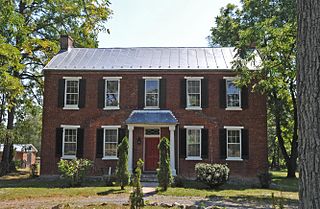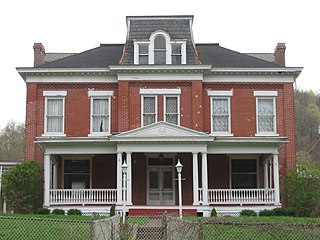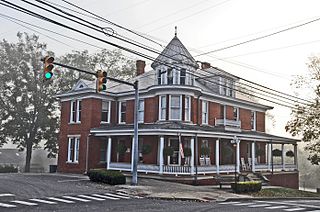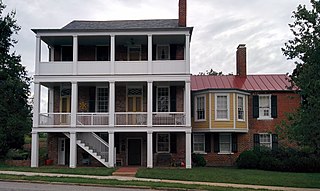The Captain David Pugh House is a historic 19th-century Federal-style residence on the Cacapon River in the unincorporated community of Hooks Mills in Hampshire County, West Virginia, United States. It is also known by its current farm name, Riversdell. It is a 2+1⁄2-story frame dwelling built in 1835. It sits on a stone foundation and has a 2+1⁄2-story addition built in 1910. The front facade features a centered porch with shed roof supported by two Tuscan order columns. The rear has a two-story, full-width porch recessed under the gable roof. Also on the property are a contributing spring house, shed, outhouse, and stone wall.

The Connor House is an historic building located in Rock Island, Illinois, United States. It was designated a Rock Island Landmark in 1987. The house was individually listed on the National Register of Historic Places in 1988, and it was included as a contributing property in the Broadway Historic District in 1998.

Washington Gold House, also known as "Mountain View" Farm, is a historic home located near Gerrardstown, Berkeley County, West Virginia. It was built in 1854 and is a two-story,"L"-shaped brick dwelling in the Greek Revival style. The house is in two sections; the front section is five bays wide and the rear section four bays deep. The front facade features a Victorian entrance porch added about 1890. Also on the property is a carriage house and small long cabin, known as the Rippey cabin for the original owner.
Baker Ropp House is a historic home located at Martinsburg, Berkeley County, West Virginia USA. It was built between 1890 and 1892, and is an "L"-shaped, two-story, brick Queen Anne-style dwelling. It is five bays wide, has a gable roof, and sits on a fieldstone foundation. It features a two-story, polygonal brick window bay and two-story frame porch. Also on the property are a brick smokehouse (1890-1892) and privy / shed (1890-1892).

The Lathrop Russell Charter House is a historic home located at West Union, Doddridge County, West Virginia, U.S.A. It was built in 1877, and is a two-story, T-shaped frame dwelling, with a low-pitched hipped roof with bracketed eaves. It features tall crowned windows and a two-story side porch. Also on the property is a contributing guest house.

The Hermitage Motor Inn — previously the Taylor Cunningham Hotel — is an historic lodge in Petersburg, Grant County, West Virginia, US. It was built about 1840, and was originally a two-story brick building in a vernacular Greek Revival style. A third story was added in the early 20th century. It features a two-story porch with turned post and balusters. It has been in continuous operation as an inn since 1881. Also on the property are the contributing wagon shed, storage cellar with granary above, log stable, and smokehouse.

Lemley-Wood-Sayer House is a historic home located at Ravenswood, Jackson County, West Virginia. It was built in 1871, and is a two-story, cruciform plan, Italianate style dwelling. It is constructed of brick and sits on a stone foundation. It features a wraparound porch supported by seven columns that are heavy with ornamental bracketing, or gingerbreading.

Nicholls House and Woolen Mill Site is a historic home and mill site located near Wellsburg, Brooke County, West Virginia. The house was built in 1893, and is a 2+1⁄2-story, red-glazed brick building in the Second Empire style. It has a tower and mansard roof. It features a full front porch with Doric order columns in the Colonial Revival style. The property also includes the site of a mill used for carding and manufacturing woolens dating to 1795.

Thornburg House is a historic home located at Barboursville, Cabell County, West Virginia. It was built in 1901, and is a two-story brick and frame dwelling with irregular massing, varied roof shapes, and large porches in the Queen Anne style. It features a corner turret with a pointed roof and a wraparound porch. Also on the property is a contributing privy.
David S. Creigh House, also known as the "Montescena" and Boone Farm, is a historic home located near Lewisburg, Greenbrier County, West Virginia. Although the house has "outstanding architectural features", it is most known for being the site of the 1863 death of a Union soldier which led to the execution of David S. Creigh, the owner, in 1864.
Meadow River Lumber Building is a historic building located on the grounds of the State Fair of West Virginia at Fairlea, Greenbrier County, West Virginia. It was built in 1928, to showcase the products of the Meadow River Lumber Company (MERILUCO). It is a one-story, Bungalow-style frame building with a small center front gable rising from the roofline. The front facade features a full length front porch.
"The Willows", also known as Randolph House, is a historic home located near Moorefield, Hardy County, West Virginia. It was built in three sections in a telescoping style. It consists of One small log house, a middle section of frame, and a brick mansion all connected end-to-end. The oldest section is the 1+1⁄2-story log structure built before 1773. The main section is a two-story, brick Greek Revival style mansion house. It features a square columned entrance porch. During the American Civil War, McNeill's Rangers used the farm for care of some of their horses. In the last year of the War, McNeill's Rangers commander Major Harry Gilmore used "The Willows" as his command.

James Weimer House is a historic home located at St. Albans, Kanawha County, West Virginia. It was built in 1917, and is a 2+1⁄2-story, brick dwelling with Classical Revival and Colonial Revival style detailing. It has a gambrel roof with original red clay tiles and dormers. It features a one-story porch running the width of the house and continuing a short distance along the side. Also on the property is a contributing brick garage.

Couch-Artrip House, also known as "Longmeadow" and "The Holmwood," is a historic home located near Southside, Mason County, West Virginia. It was built about 1830, and is a two-story brick residence in a vernacular Greek Revival-style. It features an Italianate style front porch and one-story addition, added about 1875. It also has a corbeled cornice composed of four brick courses. Also on the property are a two-room, one-story Greek Revival office / school room and a log building.

D.I.B. Anderson Farm, also known as the D.I.B. Anderson House and Chauncey M. Price House, is a historic home located in Morgantown, Monongalia County, West Virginia. It was built about 1866, and is a two-story, asymmetrical brick farmhouse in a vernacular Italianate style. It features a one-story front porch and a second story "sleeping porch." Also on the property is a contributing ice house and summer kitchen building built of hand made bricks, and a cut sandstone well house.

"Walnut Grove", also known as the Andrew Beirne House, is a historic home located near Union, Monroe County, West Virginia. It is a "T" shaped dwelling that integrates four separate structures. The oldest date to the 1780s and incorporates two, two-story log buildings. Attached to them is a formerly detached log kitchen. A two-story, Greek Revival-style brick addition was built after 1825. The entrance is in this section and features a one-story porch supported by square columns. Also on the property are a two-room frame office building, brick smokehouse, and stone springhouse. It was home to U.S. Congressman Andrew Beirne (1771–1845).

Annandale, also known as Alpine Farms, is a historic home located at Gilmore Mills, Botetourt County, Virginia. It was built in 1835, and is a two-story, Greek Revival-style brick dwelling with a deck-on-hip roof. It has a one-story, three bay, wooden front porch with tapering square columns. A two-story brick west wing and a single story frame ell, were added in 1969. Also on the property is a contributing brick dairy or meathouse.

The Rowe House is a historic home located at Fredericksburg, Virginia. It was built in 1828, and is a two-story, four-bay, double-pile, side-passage-plan Federal style brick dwelling. It has an English basement, molded brick cornice, deep gable roof, and two-story front porch. Attached to the house is a one-story, brick, two-room addition, also with a raised basement, and a one-story, late 19th century frame wing. The interior features Greek Revival-style pattern mouldings. Also on the property is a garden storage building built in about 1950, that was designed to resemble a 19th-century smokehouse.

Columbia, also known as the Philip Haxall House, is a historic home located in Richmond, Virginia. A rare surviving hi-style Federal Villa. The house name is derived from the Columbia Flour Mills which Haxall operated. It was built in 1817–1818, and is a two-story, three bay Federal style brick dwelling on a high basement. The entrance features an elliptical fanlight opening sheltered by a one-story Doric porch. It was added when the entrance was moved from the Lombardy Street side to the Grace Street side in 1924, when the building was expanded to house the T.C. Williams School of Law of the University of Richmond. In 1834 the Baptist Education Society purchased the house and it became the main academic building of Richmond College, later University of Richmond. It housed the School of Law from 1917 to 1954. In 1984 Columbia was purchased by the American Historical Foundation for its headquarters.

Crenshaw House, also known as Younger House and Clay House, is a historic home located in Richmond, Virginia. It was built in 1891, and is a three-story, Victorian Italianate style brick townhouse. The house was altered by the architectural firm of Noland and Baskervill in 1904. It features a flat roof decorated with a Doric entablature and copper cresting, a full height three-sided bay window, and an entry porch supported by paired Doric order columns. At two meetings in November 1909, a group of women met at the home to form what would become the Equal Suffrage League of Virginia (ESL).


















